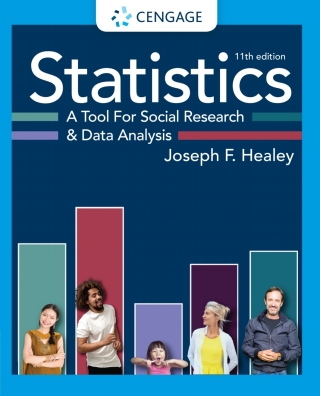Buy Statistics: A Tool for Social Research and Data Analysis, 11th Edition PDF ebook by author Joseph F. Healey; Christopher Donoghue – published by Cengage Learning in 2021 and save up to 80% compared to the print version of this textbook. With PDF version of this textbook, not only save you money, you can also highlight, add text, underline add post-it notes, bookmarks to pages, instantly search for the major terms or chapter titles, etc.
You can search our site for other versions of the Statistics: A Tool for Social Research and Data Analysis, 11th Edition PDF ebook. You can also search for others PDF ebooks from publisher Cengage Learning, as well as from your favorite authors. We have thousands of online textbooks and course materials (mostly in PDF) that you can download immediately after purchase.
Note: e-textBooks do not come with access codes, CDs/DVDs, workbooks, and other supplemental items.
eBook Details:
Full title: Statistics: A Tool for Social Research and Data Analysis, 11th Edition
Edition: 11th
Copyright year: 2021
Publisher: Cengage Learning
Author: Joseph F. Healey; Christopher Donoghue
ISBN: 9780357371152, 9780357371152
Format: PDF
Description of Statistics: A Tool for Social Research and Data Analysis, 11th Edition:
Healey’s STATISTICS: A TOOL FOR SOCIAL RESEARCH AND DATA ANALYSIS, 11e, equips you with a solid understanding of statistical fundamentals and their practical application to current social issues — no advanced math knowledge required. The text breaks down even the most complex material to help you master key concepts and develop the skills you need to succeed as a professional in a social science field — or simply to become a “”statistically literate”” consumer of social research. Everyday examples illustrate that statistics are not just abstract mathematical constructs, but they have practical value in government, education, business, media, politics, sports and more. Research examples in every chapter use the same “”real data”” that professionals use to make evidence-based decisions in social policy research, market research, social work, education and other fields.Important Notice: Media content referenced within the product description or the product text may not be available in the ebook version.
Table of Contents of Statistics: A Tool for Social Research and Data Analysis, 11th Edition PDF ebook:
Brief ContentsDetailed ContentsPrefacePrologue: Basic Mathematics ReviewChapter 1: IntroductionWhy Study Statistics?The Role of Statistics in Scientific InquiryThe Goals of This TextDescriptive and Inferential StatisticsDiscrete and Continuous VariablesLevel of MeasurementSummaryGlossaryProblemsYou are the Researcher: IntroductionPart I: Descriptive StatisticsChapter 2: Basic Descriptive Statistics: Tables, Percentages, Ratios and Rates, and GraphsFrequency Distributions for Nominal-Level VariablesEnhancing Clarity: Percentages and ProportionsFrequency Distributions for Ordinal-Level VariablesFrequency Distributions for Interval-Ratio-Level VariablesRatios, Rates, and Percentage ChangeUsing Graphs to Present DataInterpreting Statistics: Changing Patterns of American Family LifeSummarySummary of FormulasGlossaryProblemsYou are the Researcher: Is There a “Culture War” in the United States?Chapter 3: Measures of Central TendencyThe ModeThe MedianOther Measures of Position: Percentiles, Deciles, and QuartilesThe MeanThree Characteristics of the MeanChoosing a Measure of Central TendencyInterpreting Statistics: Choosing a Measure of Central Tendency to Describe IncomeSummarySummary of FormulasGlossaryProblemsYou are the Researcher: The Typical AmericanChapter 4: Measures of VariationThe Range (R) and Interquartile Range (Q)Computing the Range and Interquartile RangeThe Standard Deviation and VarianceComputing the Standard Deviation: An Additional ExampleVisualizing Variation: BoxplotsInterpreting the Standard DeviationInterpreting Statistics: The Changing Distribution of Income in the United StatesSummarySummary of FormulasGlossaryProblemsYou are the ResearcherChapter 5: The Normal CurveProperties of the Normal CurveUsing the Normal CurveThe Normal Curve Table (Appendix A)Finding the Total Area Above and Below a ScoreFinding Areas Between Two ScoresUsing the Normal Curve to Estimate ProbabilitiesSummarySummary of FormulasGlossaryProblemsYou are the ResearcherPart II: Inferential StatisticsChapter 6: Introduction to Inferential Statistics: Sampling and the Sampling DistributionProbability Sampling: Basic Concepts and TermsEPSEM Sampling TechniquesThe Sampling DistributionThe Sampling Distribution: An Additional Example Using the General Social Survey (GSS)Symbols and TerminologySummaryGlossaryProblemsChapter 7: Estimation ProceduresEstimation Selection Criteria: Bias and EfficiencyInterval Estimation ProceduresInterval Estimation Procedures Using Sample Means (Large Samples)Interval Estimation Procedures Using Sample Proportions (Large Samples)Computing Confidence Intervals: A SummaryControlling the Width of Interval EstimatesInterpreting Statistics: Predicting Election Outcomes and Judging the Performance of the PresidentSummarySummary of FormulasGlossaryProblemsYou are the Researcher: Estimating the Characteristics of the Typical AmericanChapter 8: Hypothesis Testing I: The One-Sample CaseAn Overview of Hypothesis TestingThe Five-Step Model for Hypothesis TestingChoosing a One-Tailed or Two-Tailed TestSelecting an Alpha LevelThe Student’s t DistributionTests of Hypothesis for Single-Sample Proportions (Large Samples)SummarySummary of FormulasGlossaryProblemsChapter 9: Hypothesis Testing II: The Two-Sample CaseThe One-Sample Case Versus the Two-Sample CaseHypothesis Testing with Sample Means (Large Samples)Hypothesis Testing with Sample Means (Small Samples)Hypothesis Testing with Sample Proportions (Large Samples)The Limitations of Hypothesis Testing: Significance Versus ImportanceInterpreting Statistics: Is There a Statistically Significant Gender Gap in Income?SummarySummary of FormulasGlossaryProblemsYou are the Researcher: Gender Gaps and Support for Traditional Gender RolesChapter 10: Hypothesis Testing III: The Analysis of VarianceThe Logic of the Analysis of VarianceThe Computation of ANOVAAn Example of Computing the Analysis of VarianceA Test of Significance for ANOVAAn Additional Example of Computing and Testing the Analysis of VarianceThe Limitations of the TestInterpreting Statistics: Does Sexual Activity Vary by Age?SummarySummary of FormulasGlossaryProblemsYou are the Researcher: Why Are Some People Liberal (or Conservative)?Chapter 11: Hypothesis Testing IV: Chi SquareBivariate TablesThe Logic of Chi SquareThe Computation of Chi SquareThe Chi Square Test for IndependenceColumn PercentagesThe Chi Square Test: An Additional ExampleChi Square and the Goodness-of-Fit TestThe Limitations of the Chi Square TestInterpreting Statistics: Family Values and Social ClassSummarySummary of FormulasGlossaryProblemsYou are the Researcher: Understanding Political BeliefsPart III: Bivariate Measures of AssociationChapter 12: Bivariate Association for Nominal- and Ordinal-Level VariablesAssociation and Bivariate TablesThree Characteristics of Bivariate AssociationsMeasures of Association: IntroductionMeasures of Association for Nominal VariablesMeasures of Association for Collapsed Ordinal VariablesA Measure of Association for Continuous Ordinal Variables: Spearman’s Rho (rs)Interpreting Statistics Age and Concern for the EnvironmentSummarySummary of FormulasGlossaryProblemsYou are the Researcher: Understanding Political Beliefs, Part IIChapter 13: Association Between Variables Measured at the Interval-Ratio LevelScatterplots and Regression AnalysisThe Regression LineComputing and Interpreting the Regression Coefficients (a and b)Predicting Scores on Y with the Least-Squares Regression LineThe Correlation Coefficient (Pearson’s r)Interpreting the Correlation Coefficient r2The Correlation MatrixCorrelation, Regression, Level of Measurement, and Dummy VariablesTesting Pearson’s r for SignificanceInterpreting Statistics: The Correlates of CrimeSummarySummary of FormulasGlossaryProblemsYou are the Researcher: Who Watches TV? Who Succeeds in Life?Part IV: Multivariate TechniquesChapter 14: Elaborating Bivariate TablesControlling for a Third VariableInterpreting Partial TablesPartial Gamma (Gp)Where Do Control Variables Come From?The Limitations of Elaborating Bivariate TablesInterpreting Statistics: Another Look at Concern for the EnvironmentSummarySummary of FormulasGlossaryProblemsYou are the Researcher: A Multivariate Analysis of Attitudes on AbortionChapter 15: Partial Correlation and Multiple Regression and CorrelationPartial CorrelationMultiple Regression: Predicting the Dependent VariableMultiple Regression: Assessing the Effects of the Independent VariablesMultiple CorrelationInterpreting Statistics: Another Look at the Correlates of CrimeThe Limitations of Multiple Regression and CorrelationSummarySummary of FormulasGlossaryProblemsYou are the Researcher: A Multivariate Analysis of TV Viewing and SuccessAppendix A: Area Under the Normal CurveAppendix B: Distribution of tAppendix C: Distribution of Chi SquareAppendix D: Distribution of FAppendix E: Using Statistics: Ideas for Research ProjectsAppendix F: An Introduction to SPSSAppendix G: Codebooks for All Data SetsAnswers to Odd-Numbered End-of-Chapter Problems and Cumulative ExercisesGlossaryIndex





